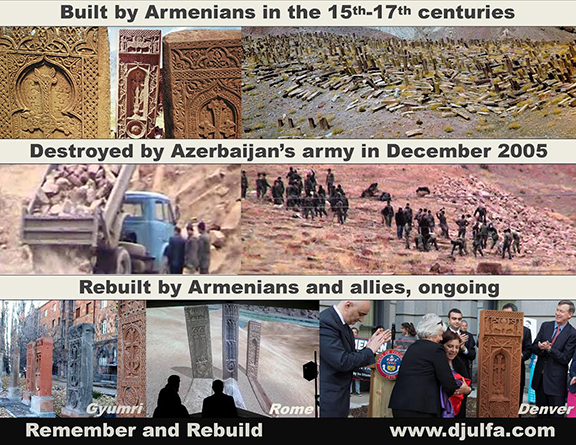
December 16 marks the 11th anniversary of destruction of 2,000 Djulfa khachkars
On the 11th anniversary of Azerbaijan’s unpunished destruction of the world’s largest medieval Armenian cemetery, the Djulfa Virtual Memorial and Museum commends ongoing initiatives to rebuild the 2,000 sacred cross-stones (khachkars) of Djulfa and calls for measures to prevent similar acts of cultural genocide in Artsakh.
Armenian communities and their supporters around the world have responded to the December 2005 destruction of Djulfa by erecting dozens of replica khachkars in many corners of the world, including on the prominent grounds of the Colorado State Capitol in the United States of America.
A groundbreaking project to recreate the entire cemetery through holographic technology is being pursued by the Australian Catholic University, albeit it is scheduled to discontinue in 2017 due to unmet fundraiser goals.
Reactions to Djulfa’s destruction have also contributed to the development of satellite archaeology. The first American Association for the Advancement of Science remote investigation of a human rights violation case that concerned cultural monuments was that of Djulfa, conducted in late 2009. This approach is widely used today for preventive and documentary monitoring of cultural properties threatened by ISIL and other terrorist organizations.
The eleventh anniversary of Djulfa’s destruction is also a cause for grave concern regarding the vast medieval Armenian heritage in Artsakh ”“ the unrecognized Republic of Nagorno-Karabakh. Its hundreds of medieval churches and other Christian monuments would likely be targeted for total destruction should Azerbaijan gain control ”“ through force or negotiation ”“ any of the Artsakh regions that were outside the Soviet boundaries of the Nagorno-Karabakh Autonomous Oblast.
Azerbaijan’s April 2016 Four Day War against Artsakh, during which Azeri forces beheaded captured Armenian soldiers and mutilated elderly civilians in Talish, demonstrated yet again the oil-rich dictatorship’s determination to ethnically cleanse indigenous Christian communities in the Caucasus. Therefore, we call on the twin states of the Armenian homeland ”“ Armenia and Artsakh, international bodies, as well as academic communities around the world to take proactive measures to protect the vast medieval Armenian heritage of Artsakh.
Founded in 2007, the Djulfa Virtual Memorial and Museum (www.Djulfa.com) documents the intentional destruction of the largest medieval Armenian cemetery at Djulfa (Old Jugha, Culfa) in the exclave of Nakhichevan (Naxçıvan), Republic of Azerbaijan. For more information, visit Djulfa.com and FB.com/SilencedStones.
The video compilation below are satellite images of a vandalized medieval cemetery at the Iranian-Azerbaijani border called “The New Tears of Araxes”